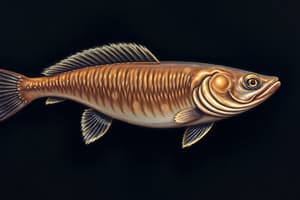Podcast
Questions and Answers
What is the function of the protruding oral hood in lampreys?
What is the function of the protruding oral hood in lampreys?
Funnel water through the muscular pharynx where food particles are trapped in mucus.
At what size and age does an ammocoete undergo major morphological and behavioral changes?
At what size and age does an ammocoete undergo major morphological and behavioral changes?
10 centimeters or longer and several years old.
How long is the typical adult life span of a lamprey?
How long is the typical adult life span of a lamprey?
No more than two years.
When did lampreys begin to expand rapidly across the Great Lakes basin?
When did lampreys begin to expand rapidly across the Great Lakes basin?
What led to the concern of sporting and commercial interests regarding lampreys?
What led to the concern of sporting and commercial interests regarding lampreys?
In which lake were sea lampreys initially unknown before 1921?
In which lake were sea lampreys initially unknown before 1921?
What is the function of the large rocks in the nest constructed by male and female lampreys?
What is the function of the large rocks in the nest constructed by male and female lampreys?
How do lampreys fertilize their eggs during breeding?
How do lampreys fertilize their eggs during breeding?
What is the fate of adult lampreys after they breed?
What is the fate of adult lampreys after they breed?
Describe the appearance of lamprey larvae, known as ammocoetes.
Describe the appearance of lamprey larvae, known as ammocoetes.
Where do the ammocoetes go after leaving the nest?
Where do the ammocoetes go after leaving the nest?
What is the purpose of the sand and smaller stones in the nest constructed by lampreys?
What is the purpose of the sand and smaller stones in the nest constructed by lampreys?
What is the reason 'Ostracoderms' is considered a paraphyletic assemblage?
What is the reason 'Ostracoderms' is considered a paraphyletic assemblage?
What distinguishes Ostracoderms from extant agnathans in terms of features like dermal bone and brain structures?
What distinguishes Ostracoderms from extant agnathans in terms of features like dermal bone and brain structures?
How did the interpretation of the relationships among different lineages of ostracoderms change over the latter part of the twentieth century?
How did the interpretation of the relationships among different lineages of ostracoderms change over the latter part of the twentieth century?
What characterizes most ostracoderms in terms of their physical appearance?
What characterizes most ostracoderms in terms of their physical appearance?
What was the range of lengths observed in ostracoderms?
What was the range of lengths observed in ostracoderms?
How do the olfactory bulbs of ostracoderms differ from those of living agnathans?
How do the olfactory bulbs of ostracoderms differ from those of living agnathans?
What is the traditional difference between gnathostomes and agnathans?
What is the traditional difference between gnathostomes and agnathans?
During what period did the form of the gnathostome lower jaw show the most variability?
During what period did the form of the gnathostome lower jaw show the most variability?
What improvements in abilities and systems characterize the derived features of gnathostomes?
What improvements in abilities and systems characterize the derived features of gnathostomes?
What evidence suggests a second Hox duplication event in living jawed vertebrates?
What evidence suggests a second Hox duplication event in living jawed vertebrates?
What group lies between living agnathans and gnathostomes, showing a stepwise acquisition of features?
What group lies between living agnathans and gnathostomes, showing a stepwise acquisition of features?
What is the significance of the variety of jaw forms stabilizing by the Devonian?
What is the significance of the variety of jaw forms stabilizing by the Devonian?
What is the function of the conus arteriosus in gnathostomes' hearts?
What is the function of the conus arteriosus in gnathostomes' hearts?
What is the significance of the type of cartilage found in gnathostomes compared to hagfishes and lampreys?
What is the significance of the type of cartilage found in gnathostomes compared to hagfishes and lampreys?
What is a key feature of the reproductive system in gnathostomes?
What is a key feature of the reproductive system in gnathostomes?
How do fins aid in the guidance of a body in three-dimensional space?
How do fins aid in the guidance of a body in three-dimensional space?
What is the role of a tail fin in propulsion?
What is the role of a tail fin in propulsion?
Why are rapid adjustments of body position important in water?
Why are rapid adjustments of body position important in water?
Flashcards are hidden until you start studying



